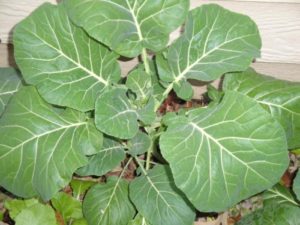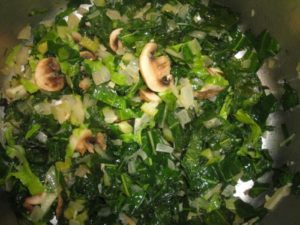Collards Soup
Here’s a hearty, healthy soup that will chase away that winter chill. Collards Soup, with greens and herbs freshly picked from the vegetable garden, offers balance to the delectables that we enjoyed over the holidays. Served with a chunk of warmed bread and melting butter…perfect!
Remember Paul Simon’s lyrics in “Sounds of Silence”? “I turned my collards to the cold and damp…” No? He didn’t say that?
Ingredients
- A few strips of bacon, cooked. Save 1 or 2 tablespoons of the fat (optional).
- A large bunch of fresh collard greens, washed, with largest part of rib removed. Cut into bite-size pieces and set aside.
- A handful of ‘Lacinato’ (dinosaur) kale or ‘Red Russian’ kale leaves, washed, with large rib removed. Cut into ribbons and add to the collards.
- 2 tablespoons butter, and more for the bread
- 3 tablespoons extra virgin olive oil
- 1 large onion, chopped
- 1 stalk celery, coarsely chopped
- 2 or 3 medium garlic cloves, minced
- A few white button mushrooms, sliced
- 3 or 4 15-ounce cans of low salt chicken broth, plus 2 or 3 cans of water
- 1 or 2 bay leaves
- 2 or 3 teaspoons apple cider vinegar
- 2 15-ounce cans of beans (cannellini, pinto, or others), drained and lightly rinsed
- 1 15-ounce can diced or stewed tomatoes
- 1/2 to 3/4 teaspoon dried thyme, or a bit more if using fresh
- 1 to 1 1/2 teaspoons dried marjoram, or 2 teaspoons fresh. Substitute Italian oregano if preferred, or use a combination. Add more herbs if desired.
- 3 tablespoons or a small handful fresh Italian (flat-leaf) parsley, coarsely chopped
- 2 to 3 cups cooked (al dente) enriched Barilla pasta (extra protein, Omega-3’s, fiber), such as elbows or mini farfalle
- Salt and pepper
- Grated Romano cheese
The Process
- Cook the bacon, reserving some of the fat. Set aside.
- In a large stockpot, heat butter and olive oil.
- Add onion and celery. Cook at medium heat, stirring, until almost tender.
- Add garlic. Cook for a few minutes, stirring. (Never brown the garlic.)
- Add collards, kale, mushrooms, and some bacon fat, if desired. Cook for a few minutes, stirring, until they turn bright green.
- Add chicken broth, water, vinegar, bay leaf, and crumbled bacon. Raise heat to a boil, then turn down to a low simmer for 15-20 minutes. Stir occasionally.
- Add beans and simmer for 10 minutes.
- Add tomatoes and thyme, and simmer, stirring occasionally, for 10 minutes.
- Add marjoram and parsley, and simmer for another 5 minutes.
- Add cooked pasta, heat, and stir.
- Salt and pepper to taste.
- Done! Now, serve with grated Romano cheese and your favorite bread. This will make about 8 servings. Add more chicken stock and water if needed.
You Can Grow Them!

Collards in the garden, late December.
Collards and kale are among the easiest crops to grow in the vegetable garden. As members of the family Brassicaceae, these plants are among the most concentrated sources of vitamins, minerals, and phytonutrients in the plant kingdom! Just one or two leaves added to omelets, pizza, store-bought soup, and rice or pasta dishes will add significantly to the meal’s nutrient content.
A few collards and several kale plants (dinosaur and ‘Red Russian’), among other crops grown through the winter, supply us with enough greens to pick almost every day. They’re super cold-hardy, and get covered with clear plastic when the temperature plummets to the low 20’s F.
On the Subject of Bacon
Since there are few occasions in this blog when the subject of bacon comes up, let me add that December 30 is National Bacon Day. We have Hernando de Soto (c. 1500-1542, Spanish explorer, looking for gold and a passage to China), to credit, or to blame, for introducing pigs to the Americas. In 1539, he brought 13 pigs to the southeastern U.S., which multiplied to a herd of 700 within 3 years. De Soto died of fever, and his body was laid to rest in the Mississippi River, which he and his crew were the first Europeans to discover.
A few morsels: About 10,000 years ago, wild pigs were domesticated in Central Asia…just under 10% of the pig is processed into bacon…just over half of American households have bacon in the refrigerator.
An occasional indulgence in foods that are generally perceived to be not so healthy is more than compensated by increasing the proportions of greens and vegetables in our diets. So, I will enjoy that bacon and a piece of good bread, guilt-free, every now and then, or these buttery biscuits that are so easy to make from scratch. Hope you enjoy this one! Happy New Year!


